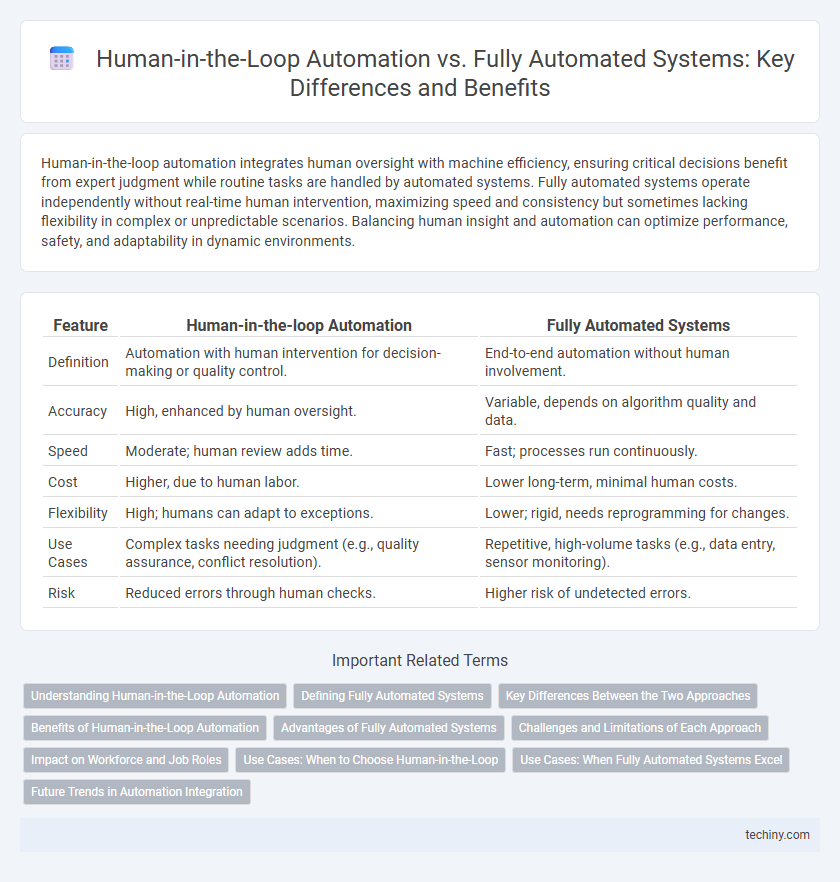Human-in-the-loop automation integrates human oversight with machine efficiency, ensuring critical decisions benefit from expert judgment while routine tasks are handled by automated systems. Fully automated systems operate independently without real-time human intervention, maximizing speed and consistency but sometimes lacking flexibility in complex or unpredictable scenarios. Balancing human insight and automation can optimize performance, safety, and adaptability in dynamic environments.
Table of Comparison
| Feature | Human-in-the-loop Automation | Fully Automated Systems |
|---|---|---|
| Definition | Automation with human intervention for decision-making or quality control. | End-to-end automation without human involvement. |
| Accuracy | High, enhanced by human oversight. | Variable, depends on algorithm quality and data. |
| Speed | Moderate; human review adds time. | Fast; processes run continuously. |
| Cost | Higher, due to human labor. | Lower long-term, minimal human costs. |
| Flexibility | High; humans can adapt to exceptions. | Lower; rigid, needs reprogramming for changes. |
| Use Cases | Complex tasks needing judgment (e.g., quality assurance, conflict resolution). | Repetitive, high-volume tasks (e.g., data entry, sensor monitoring). |
| Risk | Reduced errors through human checks. | Higher risk of undetected errors. |
Understanding Human-in-the-Loop Automation
Human-in-the-loop (HITL) automation integrates human judgment and decision-making within automated processes to enhance accuracy and handle complex or ambiguous situations. This hybrid approach allows machines to perform repetitive tasks while humans intervene during critical decision points, improving system reliability and adaptability. HITL automation is particularly valuable in industries requiring high precision and ethical considerations, such as healthcare, finance, and autonomous vehicles.
Defining Fully Automated Systems
Fully automated systems operate independently without human intervention, leveraging advanced algorithms, machine learning, and real-time data processing to execute complex tasks with high precision and efficiency. These systems are designed to continuously monitor, analyze, and respond to environmental inputs, enabling seamless performance in dynamic settings such as manufacturing, autonomous vehicles, and smart infrastructure. Key components include sensor networks, AI-driven decision-making, and robotic actuators that collectively minimize human involvement while maximizing operational speed and accuracy.
Key Differences Between the Two Approaches
Human-in-the-loop automation integrates human judgment within automated processes, allowing for intervention and decision-making at critical points to enhance accuracy and adaptability. Fully automated systems operate independently without human input, optimizing efficiency and speed through consistent, predefined algorithms and machine learning models. Key differences include the level of human involvement, responsiveness to unforeseen situations, and application suitability, with human-in-the-loop favored in complex, variable tasks and fully automated systems excelling in repetitive, high-volume operations.
Benefits of Human-in-the-Loop Automation
Human-in-the-loop automation enhances decision accuracy by integrating human judgment with machine efficiency, reducing errors in complex or unpredictable scenarios. This approach improves system flexibility, allowing operators to intervene and adapt processes in real-time based on contextual understanding and ethical considerations. Human oversight also boosts trust and accountability in automated systems, ensuring compliance with regulatory standards and facilitating continuous learning and system improvement.
Advantages of Fully Automated Systems
Fully automated systems offer increased efficiency by minimizing human error and operating continuously without fatigue, resulting in higher productivity. These systems enable faster decision-making through real-time data processing and advanced algorithms, enhancing operational speed and accuracy. Cost savings arise from reduced labor expenses and streamlined workflows, driving significant return on investment for industries employing automation technology.
Challenges and Limitations of Each Approach
Human-in-the-loop automation faces challenges such as dependency on human judgment, which can introduce variability and slow response times, limiting scalability in real-time applications. Fully automated systems struggle with limitations in handling unanticipated scenarios and lack adaptability, often requiring extensive data and complex algorithms to achieve reliable performance. Both approaches encounter difficulties balancing accuracy, efficiency, and flexibility, highlighting the need for hybrid solutions that integrate human intuition with machine precision.
Impact on Workforce and Job Roles
Human-in-the-loop automation enhances workforce collaboration by integrating human judgment with machine efficiency, leading to role evolution rather than elimination. Fully automated systems significantly reduce the need for manual intervention, resulting in workforce downsizing or shifts toward supervisory and maintenance positions. Both models demand strategic workforce reskilling to align job roles with technological advancements and maintain operational productivity.
Use Cases: When to Choose Human-in-the-Loop
Human-in-the-loop automation is ideal for complex decision-making scenarios requiring contextual understanding, such as fraud detection in finance or quality control in manufacturing. It enhances system accuracy by allowing human judgment to handle ambiguous or rare events that fully automated systems might misinterpret. Choosing human-in-the-loop is crucial when regulatory compliance or ethical considerations demand transparency and accountability in automated processes.
Use Cases: When Fully Automated Systems Excel
Fully automated systems excel in high-volume, repetitive tasks such as data entry, manufacturing assembly lines, and transaction processing where speed and accuracy are critical. These systems reduce human error and operational costs while enabling 24/7 continuous operation in environments like e-commerce order fulfillment and real-time financial trading. Industries such as logistics, healthcare diagnostics, and customer service leverage fully automated solutions to handle large-scale, standardized workflows efficiently and consistently.
Future Trends in Automation Integration
Future trends in automation integration emphasize hybrid models combining human-in-the-loop automation with fully automated systems to enhance decision accuracy and adaptability. Advances in artificial intelligence and machine learning enable seamless real-time collaboration between humans and machines, improving efficiency in complex environments such as manufacturing and autonomous vehicles. Predictive analytics and adaptive algorithms will drive smarter automation solutions, facilitating dynamic task allocation and continuous performance optimization.
Human-in-the-loop Automation vs Fully Automated Systems Infographic

 techiny.com
techiny.com